| Miso Mushroom Soup |
Some people refer to miso soup as Japan’s chicken soup. Not only is miso soup pure comfort food, but it also contains lots of nutrients and is believed to have some cancer fighting properties.
At its most basic, miso soup is made with dashi, a Japanese “mother” stock, miso, wakame seaweed, and tofu. Miso is a fermented bean paste, made from soybeans (or other beans), grain (rice, barley or wheat) and salt. Miso can be light (kome miso, made from rice and soybeans), medium (mugi miso, made from barley and soybeans) or dark (hatcho miso, made from just soybeans) in color. There are other varieties of misos available, but these are the most common.
Dashi and wakame seaweed are two other ingredients in miso soup. Traditional dashi is made with kombu, a sea vegetable, and bonito flakes (bonito fish flakes), although vegetarian dashi is also quite common.
| Dried Kombu |
Kombu and wakame seaweed, which are sea vegetables, contain anti-inflammatory and antioxidant compounds that are believed to reduce the risk of colon cancer and breast cancer. Sea vegetables have also been shown to lower blood levels of total cholesterol and LDL-cholesterol.
However, there is currently some confusion and controversy surrounding soy products and its effects on hormone dependent breast cancer, due to estrogen-like substances (isoflavones) in soy that may stimulate estrogen receptors of breast cancer cells. The American Institute for Cancer Research says women receiving anti-estrogen treatments such as tamoxifen should minimize soy foods.
When I cook for people with hormone dependent breast cancer, I generally avoid soy products (I do use soy sauce occasionally, which does not contain isoflavones). Fortunately, there are now misos made from other beans such as azuki miso and chickpea miso, so people with hormone dependent breast cancer can enjoy miso soup, and get the health benefits of sea vegetables.
Miso soup is actually very simple to prepare at home. Here’s how to make your own miso soup at home.
How To Make Vegetarian Dashi
Vegetarian Dashi
Ingredients
- 1 strip kombu seaweed 12" piece
- 6 cups water
Instructions
-
Wipe kombu with a damp paper towel to remove any dust. Do not wash it. Use a sharp knife to make a few cuts in the strip of kombu. Place in a bowl with the water. Let sit 4-12 hours at room temperature (the longer you soak kombu, the more flavorful the broth), or overnight in the refrigerator. Remove kombu.
-
Alternatively, place water and kombu in a medium size pan over medium heat. Remove kombu just before water reaches a full boil. Turn off heat.
-
Dashi can be frozen (I do this so I can make miso soup and other soups whenever the whim strikes me).
Miso Soup with Mushrooms
Miso Soup with Mushrooms
Ingredients
- 1/2 cup wakame seaweed
- 3 cups dashi
- 3 tablespoons hatcho miso
- 3 mushrooms sliced
- 1 cup tofu cubed
- 1/4 cup scallions minced
Instructions
-
Soak wakame seaweed in water to cover, and let sit 10 minutes to rehydrate.
-
Bring dashi to a boil in a medium size pan. Mix miso with some dashi to make a thin paste.
-
Stir miso into dashi, and add rehydrated wakame seaweed, mushrooms and tofu. Bring to a boil, then remove from heat.
-
Serve miso soup immediately, garnished with scallions.
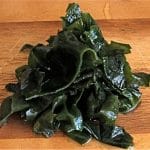
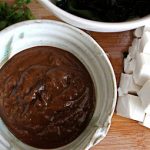


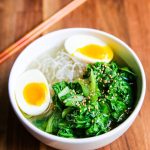
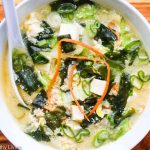
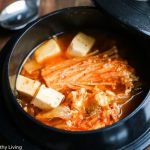





looks delicious! craving for some miso now!
I love miso soup but never thought about making it myself! Can you find the ingredients at the regular grocery store or do you need to go to an Asian market?
It's easy and quick to cook, especially if you make the cooked dashi. Just had some for breakfast again today.
Whole Foods carries sea vegetables (including kombu and wakame seaweed) and miso. Dried seaweed lasts a long time, so if you find it, just a little extra. Miso can now be found in some supermarkets as well.
A wonderful receipe, but . . . Please do not boil miso! It says right on the package NOT to boil. Boiling will ruin any health benefits of the miso. Add to hot water and heat, but DO NOT BOIL!!
Thanks for your comment on not boiling the miso.